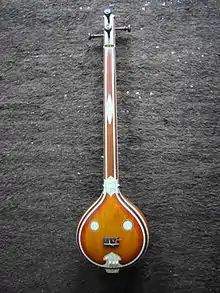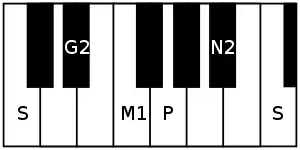Udayaravichandrika
Udayaravichandrika is a rāgam in Carnatic music (musical scale of South Indian classical music). It is an audava rāgam (or owdava rāgam, meaning pentatonic scale ). It is a janya rāgam (derived scale), as it does not have all the seven swaras (musical notes). The equivalent of Udayaravichandrika in Hindustani music is Dhani.[1][2]
| Arohanam | S G₂ M₁ P N₂ Ṡ |
|---|---|
| Avarohanam | Ṡ N₂ P M₁ G₂ S |
| Equivalent | Minor pentatonic scale |
| Carnatic music |
|---|
 |
| Concepts |
| Compositions |
| Instruments |
|
Structure and Lakshana

Udayaravichandrika is a symmetric rāgam that does not contain rishabham or dhaivatam. It is a pentatonic scale (audava-audava rāgam in Carnatic music classification - audava meaning 'of 5') and is equivalent to the Minor Pentatonic Scale in Western Music.[3] Its ārohaṇa-avarohaṇa structure (ascending and descending scale) is as follows (see swaras in Carnatic music for details on below notation and terms):
The notes used in this scale sadharana gandharam, shuddha madhyamam, panchamam and kaisiki nishadham. Udayaravichandrika is considered a janya rāgam of Kharaharapriya, the 22nd melakarta rāgam,[2] though it can be derived from other melakarta rāgams, Hanumatodi, Natabhairavi or Natakapriya, by dropping both rishabham and dhaivatam.
Udayaravichandrika and Suddha Dhanyasi are closely related, so much that many performers treat the two as interchangeable. Some contemporary practitioners consider Shuddha Dhanyasi as more inflected (i.e., using more gamakas), and Udayaravichandrika to be more in the Hindustani tradition with almost bare (i.e., uninflected) notes. Puritans, however, refer to the fact that Udayaravichandrika is an ancient raga in the Venkatamakhin tradition and was reputed to be created by Muthuswamy Dikshitar himself. However, at that time, it had kakali nishadam rather than the kaisiki nishadam of Suddha Dhanyasi.
However, the Kaisaki nishadam is used in this topic making more towards Sudha Dhanyasi. The Udaya Ravichandrika, in its pure form should have the following arohana and avarohana:
arohanam = S G₂ M₁ P N₃ Ṡ avarohanam = Ṡ N₃ P M₁ G₂ S
In recent years this distinction seems to have blurred, and both ragas are considered roughly equivalent.
Popular compositions
Here are some popular kritis composed in Suddha Dhanyasi raga.
- Enta nerchina by Thyagaraja
- subrahmaṇyena rakṣito'haṃ and śrī pārthasārathinā by Muthuswami Dikshitar
- Himagiri tanaye by Muthiah Bhagavatar
- Bhavamu lona by Annamacharya
- Narayana Ninna Namada by Purandara Dasa
- śrī hari-vallabhē by Mysore Vasudevachar
- śarvaṃ samāśraye'haṃ by Tulasivanam (pen-name of Ramachandran Nair from Kerala, India)
- khēlati piṇḍāṇḍē bhagavān by Sadasiva Brahmendra
- kālātītāya khaṭvāṅginē namastē by Muthiah Bhagavatar
- bhēruṇḍāmbē bēḍuvē by Muthiah Bhagavatar
- āyar pāḍi kaṇṇā by Padma Viraraghavan
- pālaya māṃ siddhi vināyaka by Mysore Sadashiva Rao
Film Songs
Language:Tamil
Language:Malayalam
| Song | Movie | Composer | Singer |
|---|---|---|---|
| Souparnikamrutha Veechikal | Kizhakkunarum Pakshi | Raveendran | KJ Yesudas |
Album Song
Language:English
| Song | Artist | Producer | Singer | Album |
|---|---|---|---|---|
| I'll Be Gone | Linkin Park | Mike Shinoda, Rick Rubin | Chester Bennington | Living Things |
| Shape of You | Ed Sheeran | Ed Sheeran, Steve Mac | Ed Sheeran | ÷ |
Related rāgams
This section covers the theoretical and scientific aspect of this rāgam.
Graha bhedam
Udayaravichandrika's notes when shifted using Graha bhedam, yields 4 other major pentatonic rāgams, namely, Mohanam, Hindolam, Madhyamavathi and Shuddha Saveri. Graha bhedam is the step taken in keeping the relative note frequencies same, while shifting the shadjam to the next note in the rāgam. See Graha bhedam on Mohanam for more details and illustration of this concept.
Scale similarities
- Dhanyāsi is a rāgam which has the ascending scale of Udayaravichandrika (Shuddha Dhanyasi) and descending scale of Hanumatodi. Its ārohaṇa-avarohaṇa structure is S G₂ M₁ P N₂ Ṡ: Ṡ N₂ D₁ P M₁ G₂ R₁ S
- Abheri is a rāgam which has the ascending scale of Udayaravichandrika and descending scale of Kharaharapriya. Its ārohaṇa-avarohaṇa structure is S G₂ M₁ P N₂ Ṡ: Ṡ N₂ D₂ P M₁ G₂ R₂ S
Notes
References
- Ragas in Carnatic music by Dr. S. Bhagyalekshmy, Pub. 1990, CBH Publications
- Raganidhi by P. Subba Rao, Pub. 1964, The Music Academy of Madras
- "basicmusictheory.com: C minor pentatonic scale". www.basicmusictheory.com. Retrieved 19 December 2017.
